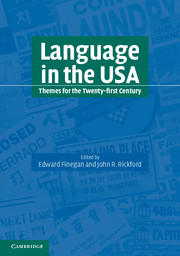Book contents
- Frontmatter
- Contents
- List of figures
- List of tables
- List of contributors
- Acknowledgments
- Foreword
- Editors' preface
- Part 1 American English
- Part 2 Other language varieties
- Part 3 The sociolinguistic situation
- 15 Language ideology and language prejudice
- 16 Ebonics and its controversy
- 17 Language planning, language policy, and the English-Only Movement
- 18 Language in education
- 19 Adolescent language
- 20 Slang
- 21 Hip Hop Nation Language
- 22 Language, gender, and sexuality
- 23 Linguistic identity and community in American literature
- 24 The language of doctors and patients
- 25 The language of cyberspace
- 26 Language attitudes to speech
- Index
22 - Language, gender, and sexuality
Published online by Cambridge University Press: 05 June 2012
- Frontmatter
- Contents
- List of figures
- List of tables
- List of contributors
- Acknowledgments
- Foreword
- Editors' preface
- Part 1 American English
- Part 2 Other language varieties
- Part 3 The sociolinguistic situation
- 15 Language ideology and language prejudice
- 16 Ebonics and its controversy
- 17 Language planning, language policy, and the English-Only Movement
- 18 Language in education
- 19 Adolescent language
- 20 Slang
- 21 Hip Hop Nation Language
- 22 Language, gender, and sexuality
- 23 Linguistic identity and community in American literature
- 24 The language of doctors and patients
- 25 The language of cyberspace
- 26 Language attitudes to speech
- Index
Summary
Editors' introduction
A chapter called “Language, Gender, and Sexuality” could hardly have appeared in the first Language in the USA because the field of language and gender studies was too young in 1980. Mary Bucholtz here contextualizes her discussion of the subject within the historical, intellectual, and political forces at play in recent decades, and she illustrates how fluid both language use and scholarly understanding of it can be. For decades, many sociolinguists had established correlations between linguistic features such as pronunciations and grammatical forms with fixed social categories like socioeconomic status, sex, and ethnicity. A notable development in the late twentieth century was the rise of feminist studies, gender studies, and studies of sexuality in language and literature. This chapter analyzes language variation from these latter perspectives.
Beginning with “the fundamental insight of feminism” that “the personal is political,” Bucholtz describes analyses of women's language in the 1970s and the unprecedented move to replace sexist nouns like fireman and stewardess and sexist pronouns like he (meaning ‘he and she’) with nongendered expressions (firefighter, flight attendant, he and she, s/he). Less well known is the notion of indexes – how “identities form around practices and … practices develop around identities.” The chapter shows that temporary identities (interaction-specific identities, Bucholtz calls them) such as ring maker or hopscotch player can take precedence over broader identities such as girl, African American, or Latina.
- Type
- Chapter
- Information
- Language in the USAThemes for the Twenty-first Century, pp. 410 - 429Publisher: Cambridge University PressPrint publication year: 2004
- 4
- Cited by



